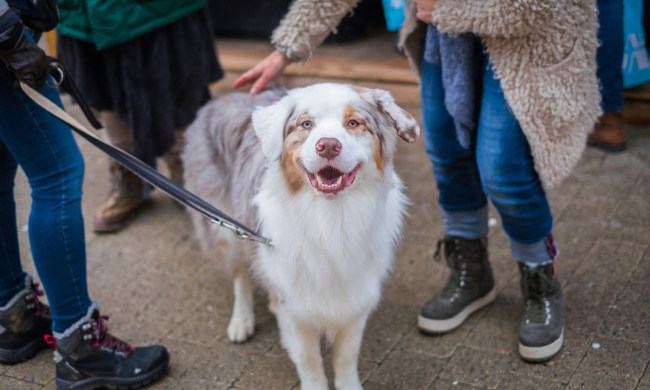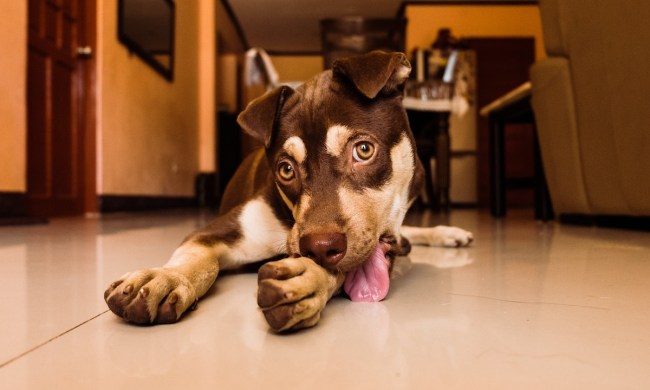So, your usually ravenous dog isn’t interested in his kibble much lately, and you’re wondering if it’s time to change his diet. You’ve heard about the trend toward homemade dog food and are thinking you’ll give it a try. Should you make the switch?
If you do, you’ll be in good company. A recent study by the University of Guelph Ontario Veterinary College in Canada found that 87% of dog owners give their pets some real food (read: suitable for humans) as part of their diet. And yet, it’s hard to discount the value of commercial dog food, reliably produced by an industry that dates back to the mid-1800s.
Which option is best for your dog — homemade or store-bought? Here is a quick comparison to help you decide.
Fresh ingredients
Without question, homemade dog food wins in this category. When you commit to making your dog his meals, you can choose the freshest ingredients to feed him. Most commercially made dog food has a long shelf life. A bag of unopened dry dog food can last as long as 18 months; unopened canned food is good for two years. That’s why it’s important to check the expiration date on every bag or can of food you purchase.
Even with fresh-dog-food subscription services, such as The Farmer’s Dog, which says their meals arrive at your door within days of being prepared, there is a bit of a lag. If you’re concerned about feeding your dog the freshest ingredients, homemade wins the day.
Nutritional value
You might think that homemade dog food beats kibble here, too, but that’s not always the case. Dogs have distinctly different nutritional needs and digest food differently than humans, which means homemade meals might lack healthy ingredients that dogs need. In fact, when researchers at the University of California–Davis School of Veterinary Medicine evaluated 200 popular dog food recipes, they found 95% to be missing necessary levels of at least one essential nutrient.
In comparison, all dog food manufactured in the United States must meet U.S. Department of Agriculture requirements for balanced nutrition. Ingredients are regulated by the Center for Veterinary Medicine, which is a branch of the U.S. Food and Drug Administration. The Association of American Feed Control Officials is responsible for the enforcement of state laws regarding the safe production and labeling of animal food.
What’s the verdict? When it comes to nutritional value, store-bought food is the best choice for an active, healthy dog. The recipes are formulated for each stage of your dog’s life as well as his special dietary needs, which is something that’s hard to get right in your own kitchen.
Safety
We’re calling this one a tie.
Let’s address the elephant in the room first. We’ve seen a lot of dog food recalls in the past 15 years, which is one of the reasons homemade dog food is now so popular. In a 2007 incident, nearly 180 pet food companies voluntarily recalled their products, which were reportedly responsible for causing kidney failure and death in thousands of dogs and cats in the United States and Canada.
What do you have to fear by making homemade dog food? Much the same risk. Foodborne illness isn’t exclusive to commercial dog food. A 2010 study determined that less than 2% of reported foodborne illness cases were related to pet food. That’s in comparison to 76 million foodborne illness cases worldwide that cause nearly 5,000 human fatalities every year.
And when you’re cooking for your dog, you need to know which common foods are potentially harmful — or even fatal — for canine consumption. A short list includes avocado, chocolate, grapes, and raisins.
Cost
Is it less expensive to make meals for your dog? Not necessarily. Here are some variables to consider:
- Budget. Store-bought dog food prices range anywhere from slightly less than $1/pound for dry kibble to more than $20 for a 13-ounce can. Determine how much you currently pay per meal so you can have an accurate picture of how much it will cost to switch.
- Ingredients. If you switch to homemade, what ingredients will you need? How much do they cost and are they readily available where you live? For example, duck is a common ingredient in homemade meals, but it’s typically more expensive than chicken and harder to find year-round.
- Time and effort. How much is your time worth? Store-bought dog food is fairly straightforward: Simply open the bag and serve the correct portion. Homemade dog food, by contrast, takes more effort. Besides shopping for the right ingredients, you must put in the time and effort to cook and store the meals properly.
Final verdict
There’s a lot to consider when you’re trying to decide whether to feed your dog store-bought or homemade meals. His age, health, and lifestyle, along with your budget and availability, should all be part of the equation.
Before you decide, be sure to consult with your veterinarian or a board-certified veterinary nutritionist. She is the expert on your dog’s health and can help you make educated decisions about how to achieve optimal health. Working together, you can rest assured that your dog is receiving the best nutrition for his health, happiness, and longevity.


